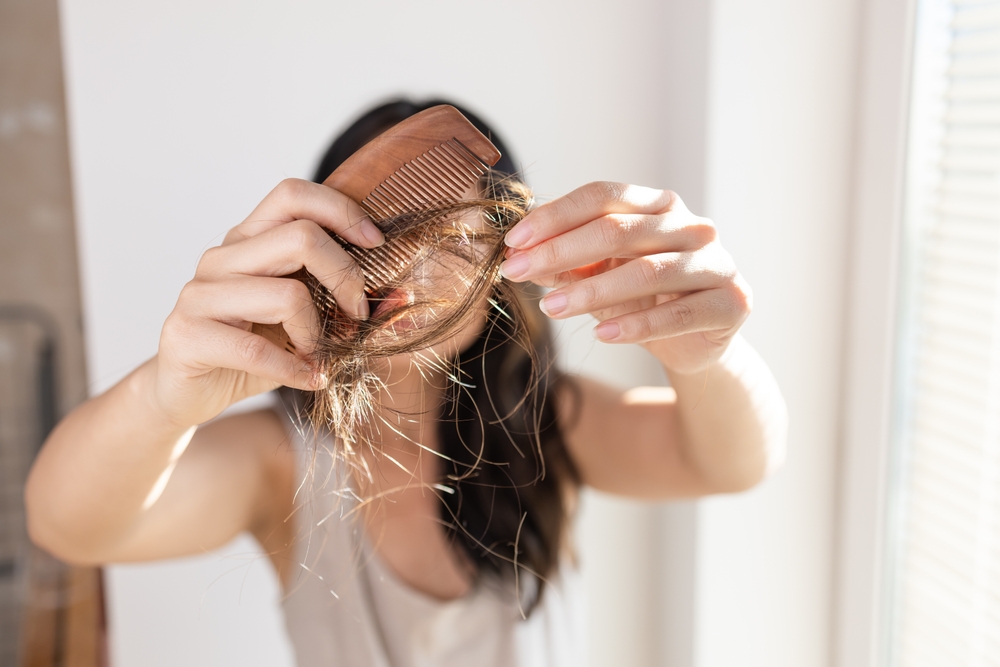According to statistics, 35 million men and 21 million women suffer from hair loss worldwide, with females who experience high stress levels 11 times more likely to lose their locks.
Three types of hair loss can be associated with high stress levels – telogen effluvium (excessive shedding), alopecia areata (an autoimmune disorder) and trichotillomania (urge to pull hair out).
The most common, telogen effluvium, is a form of hair loss characterised by hair thinning and an increase in hair shedding and can be triggered by significant stress or a traumatic event. With this type, less hair is grown during the anagen phase, making the hair growth process significantly slower and pushing a large number of hair follicles into the telogen/resting phase.
The general advice to tackle the issue long-term is to make improvements to your diet, commit to a regular exercise routine, engage in calming practices and be mindful of harsh chemicals in your haircare products.
But what can you do to tackle stress-related hair thinning in the short term? After all, looking and feeling good about your locks is bound to ease the tension slightly.

Switch up your parting
When your hair starts to thin, it’s usually around the top of your head, at the crown where you part your hair and occasionally at the sides near your temples.
To tackle thinning, consider switching up where you part your hair. If you usually wear it in the middle but find it thinning at the front and centre, swap to a side parting by sweeping the hair from one side to the other. Or if you’re a side-parting kind of girl with thinning around one side, try a centre parting.
Swapping your hair part and moving your hair in a different direction will provide extra cover for any thinning areas and give the hair a little lift as the hair adjusts to laying in that direction.
Experiment with different hairstyles
Rather than relying on the same old hairstyles, an alternative look may help to hide thinning whilst your hair grows back.
For example, a low ponytail is a great hairstyle that alleviates any strain on your locks and allows the hair to fall naturally. Simply pull your hair back into a ponytail at the nape of your neck and secure it with a silk scrunchie or spiral hair bobble. If you want it to look fuller, consider adding a clip-in ponytail.
Meanwhile, if your hair is looking a bit sparse, adding a blow dry or curls to your locks in the morning can be a great way to add volume, camouflage any thinning and make your hair look thicker.
Invest in Hair Extensions
To add volume, length and volume to thinning locks and help disguise any thinning patches, consider investing in a set of hair extensions.
Before committing to a set, consider what type of extension you are going for. For example, clip-in hair extensions are the best option for a quick fix, as they are easy to maintain, clean and take off, while tape extensions are a more permanent yet natural-looking low-maintenance option.
Quality is crucial, too, if you want them to last a bit longer. Synthetic hair might be cheaper and look shinier, but will most likely get tangled easily and not hold styles or textures. Remy – human hair with the cuticle still intact – which is slightly more expensive, will last a lot longer, blend better and be easier to style.
And it’s important to opt for the right length and colour to suit you. Lengths generally range from 12″ to 24″ inches – with 12″ or 16″ the recommended for anyone with short-mid length hair. Meanwhile, most suppliers provide a shade-matching service, where you send in a picture of your hair in natural light to allow the experts to provide the best match possible.
By Hair Expert Nicole Petty at Milk + Blush





